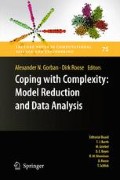Abstract
The solution to the problem of finding the reaction kinetic realization of a given system obeying the mass action law containing the minimal/maximal number of reactions and complexes is shown in this paper. The proposed methods are based on Mixed Integer Linear Programming where the mass action kinetics is encoded into the linear constraints. Although the problems are NP-hard in the current setting, the developed algorithms give a usable answer to some of the questions first raised in [1].
Access this chapter
Tax calculation will be finalised at checkout
Purchases are for personal use only
Preview
Unable to display preview. Download preview PDF.
References
Hárs, V., Tóth, J.: On the inverse problem of reaction kinetics. In: Qualitative Theory of Differential Equations, Farkas, M., Hatvani L. (eds.). North-Holland, Amsterdam (1981) 363–379
Farina, L., Rinaldi, S.: Positive Linear Systems: Theory and Applications. Wiley, NY (2000)
Samardzija, N., Greller, G.D., Wassermann, E.: Nonlinear chemical kinetic schemes derived from mechanical and electrical dynamical systems. Journal of Chemical Physics 90(4) (1989) 2296–2304
Horn, F., Jackson, R.: General mass action kinetics. Archive for Rational Mechanics and Analysis 47 (1972) 82–116
Haag, J., Wouver, A., Bogaerts, P.: Dynamic modeling of complex biological systems: a link between metabolic and macroscopic description. Mathematical Biosciencs 193 (2005) 25–49
Sonta, E.: Structure and stability of certain chemical networks and applications to the kinetic proofreading model of T-cell receptor signal transduction. IEEE Trans. Autom. Control 46 (2001) 1028–1047
Angeli. D.: A tutorial on chemical network dynamics. European Journal of Control 15 (2009) 398–406
Chellaboina, V., Bhat, S.P., Haddad, W.M., Bernstein., D.S.: Modeling and Analysis of Mass-Action Kinetics – Nonnegativity, Realizability, Reducibility, and Semistability. IEEE Control Systems Magazine 29 (2009) 60–78
Schnell, S., Chappell, M.J., Evans, N.D., Roussel, M.R.: The mechanism distinguishability problem in biochemical kinetics: The single-enzyme, single-substrate reaction as a case study. Comptes Rendus Biologies 329 (2006) 51–61
Craciun, G., Pantea, C.: Identifiability of chemical reaction networks. Journal of Mathematical Chemistry 44 (2008) 244–259
Szederkényi, G.: Comment on Identifiability of chemical reaction networks by G. Craciun and C. Pantea. Journal of Mathematical Chemistry 45 (2009) 1172–1174
Floudas, C.A.: Nonlinear and mixed-integer optimization. Oxford University Press, London (1995)
Gorban, A.N., Karlin I.V.: Method of invariant manifold for chemical kinetics. Chemical Engineering Science 58 (2003) 4751–4768
Hardin, H.M., can Schuppen, J.H.: System reduction of nonlinear positive systems by linearization and truncation. Lecture Notes in Control and Information Sciences 341 (2006) 431–438
Szederkenyi, G.: Computing sparse and dense realizations of reaction kinetic systems. J. Math. Chem. 47(2) (2010) 551–568
Hangos, K.M., Szederkényi, G.: Special Positive Systems: the QP and the Reaction Kinetic System Class. In: Preprints of the Workshop on Systems and Control Theory in honor of József Bokor on his 60th Birthday, Hungarian Academy of Sciences (2008)
Feinberg, M.: Lectures on chemical reaction networks, Notes of lectures given at the Mathematics Research Centre, University of Wisconsin (1979)
Bang-Jensen, J., Gutin, G.: Digraphs: Theory, Algorithms and Applications. Springer, Berlin (2001)
Feinberg, M.: Chemical reaction network structure and the stability of complex isothermal reactors – I. The deficiency zero and deficiency one theorems. Chemical Engineering Science 42(10) (1987) 2229–2268
Gorban A.N., Karlin, I.V., Zinovyev, A.Y.: Invariant grids for reaction kinetics. Physica A 33 (2004) 106–154
Craciun, G., Feinberg, M.: Multiple equilibria in complex chemical reaction networks: I. The injectivity property. SIAM Journal on Applied Mathematics 65(5) (2005) 1526–1546
Erdi, P., Tóth, J.: Mathematical Models of Chemical Reactions. Theory and Applications of Deterministic and Stochastic Models. Manchester University Press, Manchester; Princeton University Press, Princeton (1989)
Feinberg, M.: Chemical reaction network structure and the stability of complex isothermal reactors – II. Multiple steady states for networks of deficiency one. Chemical Engineering Science 43 (1988) 1–25
Nemhauser, G.L., Wolsey, L. A.: Integer and Combinatorial Optimization. Wiley, NY (1988)
Löfberg, J.: YALMIP : A Toolbox for Modeling and Optimization in MATLAB In: Proceedings of the CACSD Conference, Taipei, Taiwan (2004)
Makhorin, A.: GNU Linear Programming Kit. Reference Manual. Version 4.10 (2006)
Homlstrm, K., Edvall, M.M., Gran, A.O.: TOMLAB for large-scale robust optimization. In: Nordic MATLAB Conference (2003)
Aykanat, C., Pinar, A.: Permuting sparse rectangular matrices into block-diagonal form. SIAM J. Scientific Computing 25 (2004) 1860–1879
Donoho, D.L., Tanner, J.: Sparse nonnegative solution of underdetermined linear equations by linear programming. Proc. of the National Academy of Sciences of the USA (PNAS) 102 (2005) 9446–9451
Donoho, D.L.: For most large undetermined systems of linear equations the minimal l1-norm solution is also the sparsest solution. Communications on Pure and Applied Mathematics 59 (2006) 903–934
Lotka, A.J.: Undamped oscillations derived from the law of mass action. J. Am. Chem. Soc. 42 (1920) 1595–1599
Wilhelm, T.: The smallest chemical reaction system with bistability. BMC Systems Biology 3 (2009) 90
Acknowledgements
This work was supported by the Hungarian National Research Fund (OTKA K-67625). The first author is a grantee of the Bolyai scholarship of the Hungarian Academy of Sciences.
Author information
Authors and Affiliations
Corresponding author
Editor information
Editors and Affiliations
Rights and permissions
Copyright information
© 2011 Springer-Verlag Berlin Heidelberg
About this paper
Cite this paper
Szederkényi, G., Hangos, K.M., Csercsik, D. (2011). Computing Realizations of Reaction Kinetic Networks with Given Properties. In: Gorban, A., Roose, D. (eds) Coping with Complexity: Model Reduction and Data Analysis. Lecture Notes in Computational Science and Engineering, vol 75. Springer, Berlin, Heidelberg. https://doi.org/10.1007/978-3-642-14941-2_13
Download citation
DOI: https://doi.org/10.1007/978-3-642-14941-2_13
Published:
Publisher Name: Springer, Berlin, Heidelberg
Print ISBN: 978-3-642-14940-5
Online ISBN: 978-3-642-14941-2
eBook Packages: Mathematics and StatisticsMathematics and Statistics (R0)

